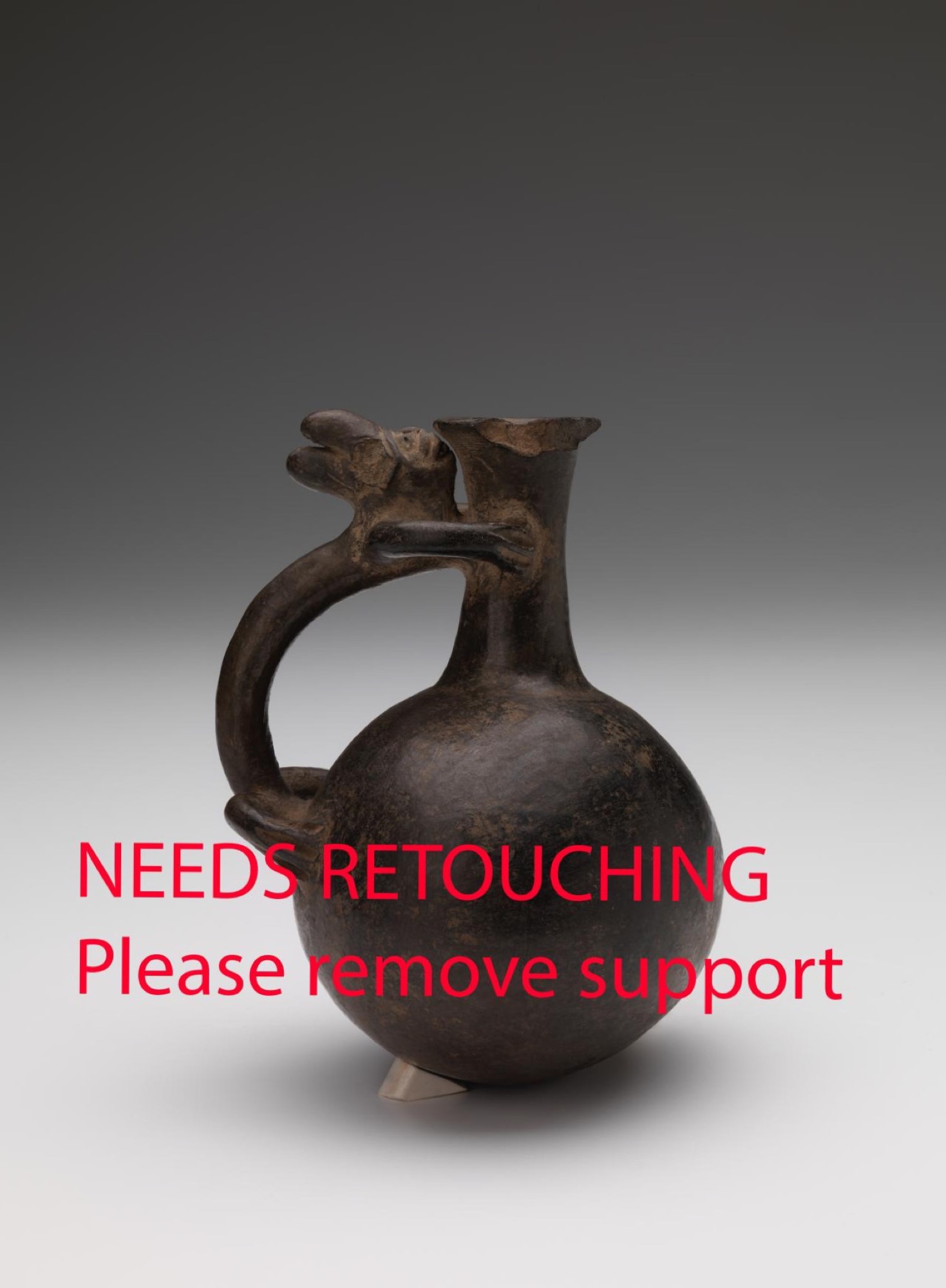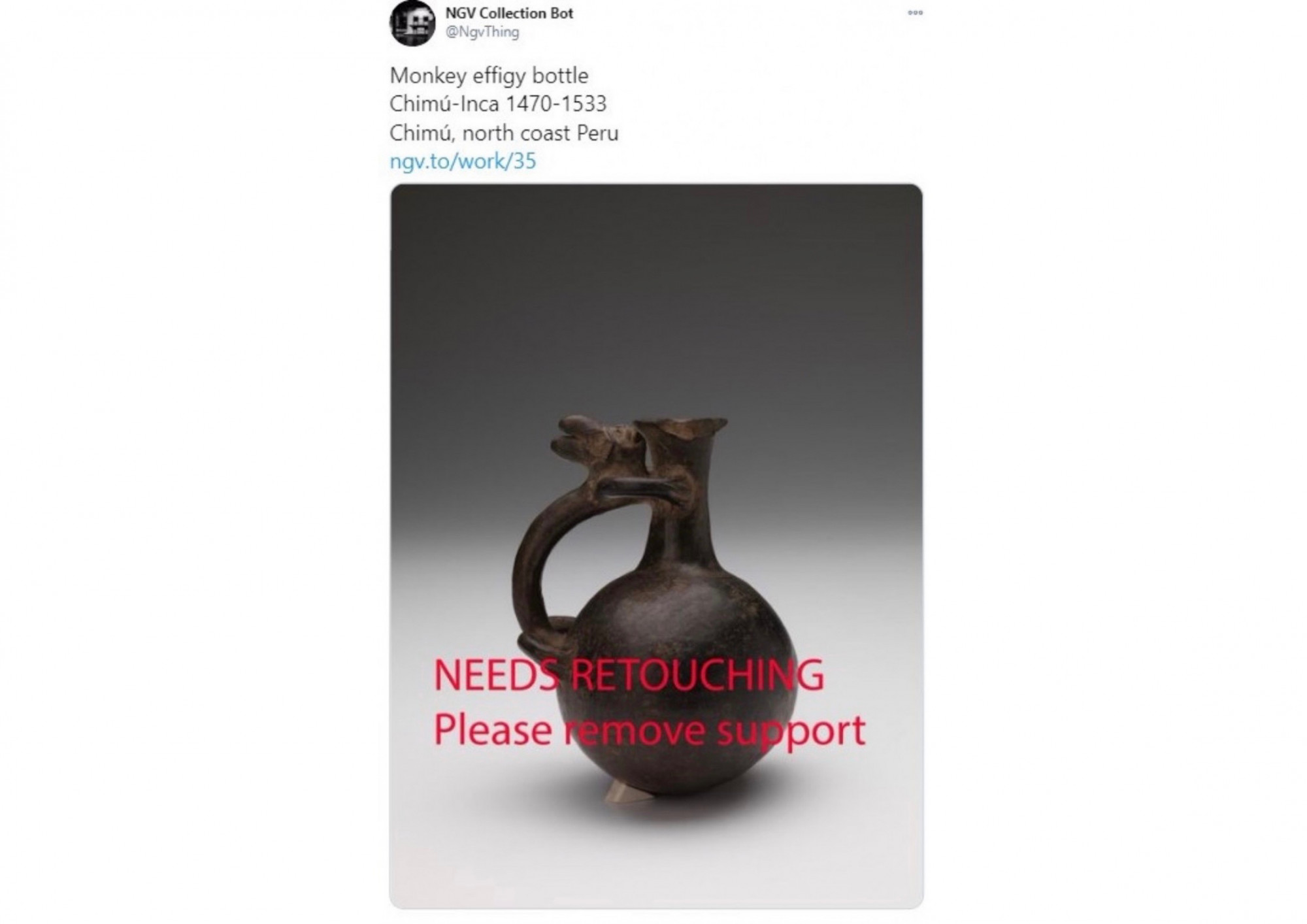
The public is extremely interested in art gallery storage: what percentage of the collection is currently not on display, how things are protected while stored, the (true) legends about rooms that cut off oxygen for the purpose of extinguishing a fire without water–keeping priceless treasures safe while potentially asphyxiating trapped workers. Gallery guides love to offer visitors these titbits and people lap them up. The submerged portion of the collection that is locked away acts as a monstrous subconscious hoard in opposition to the delicately curated display. At any given moment we want to see what they won’t let us see more than what they want to show us.

The NGV Collection Bot—or @NgvThing, its handle—is a Twitter user that randomly posts an image of an artwork from the National Gallery of Victoria collection once an hour, on the 39th minute of every hour. For that one hour an artwork gets to state its name at the top of the feed, before being squashed down the line.
I do not know exactly how its algorithm works, or who programmed it (the creator has disabled direct messages, and like many similar unofficial ‘art collection bots’ on Twitter, such as MoMA bot, @NgvThing is “not affiliated with the NGV”). However, despite initially detecting paranoic patterns in its posts (I naïvely believed that it was selecting artworks that I personally would enjoy), I now concede that it appears truly randomised, plucking one item out of the total number of possible objects, with the exception that the item must be photographed so that the bot isn’t shooting out an endless stream of blank placeholder files. The NGV holds 75,000 artworks in its collection and its website notes that about half of that collection is fully “digitised” with images. If the bot didn’t repeat artworks (which it does), then it would be done with unique posts in about four years. It began its rhythmic tweeting in April 2017.

Because the NGVbot has no other criteria for its curation, because it plumbs the quantity not the quality of the collection, its feed is a little like looking under the NGV’s mattress. Unlike the official NGV Twitter account, the bot ignores the smiling face of the institution in favour of its bloated belly. So, while @Ngvthing appears to run on a basic algorithm, what it gradually communicates is a complex 159-year history of cultural accumulation in Melbourne.

The bot dwells not in the charismatic masterpieces of the collection (although those come up every now and again). Maybe Twitter isn’t a great place to survey the epic Martu women’s collaborative painting Ngayarta Kujarra, 2009 (above). The bot is better for the things that the NGV owns a lot of: the modest and cheaper pieces, the artworks acquired in bulk. And because of the restricted focus (the bot only tweets one image from one angle), it is the perfect platform to receive works of an intimate scale. For example, decorative arts are king here. Glittering enamel, glazed ceramics, glowing plastic, and coloured glass that catches the light all glisten from the otherwise muddy cesspit of Twitter.com. Small things shine in the spotlight of the bot.

Works on paper like prints and drawings usually represent the majority of any gallery’s collection. Easy to accumulate in endless boxes, paper artworks stack up in storage. Because the bot only features one image per artwork, paper-works lead to the most common “errors”, where the bot will tweet an image of a print portfolio or book but show only the blank front page. Errors like this, or when the photograph is otherwise “wrong”, get the bot lots of likes. While its posts commonly get zero likes and zero retweets, one of a Monkey effigy bottle from the Chimú or Inca peoples from Peru with the editorial note in red got a healthy eight hearts. Normally the bot performs its task with an utter relentlessness, so it is only glitches like this that remind us of the human activity of arts workers behind the catalogue: the photographer, the art handler, the digital catalogue manager, the image editor who neglected to remove the support.

I am sure Fred Williams is the Australian artist best represented by the NGV, as his entire print collection is held there, and his etchings come up almost every day. His prominence is here made visual. Don’t quote me, but I remember being told that the single artist with the most artworks held by the NGV is the British illustrator Charles Samuel Keene, a niche figure. The “unrivalled collection of Keene drawings” was a gift from artist and artworld insider Lionel Lindsay. As they appear and reappear regularly on my screen, I slowly witness their oeuvres—appreciatively in Williams’ case and less so in Keene’s. I am also frequently reminded that the days of public institutions buying (or even accepting gifts) of a bulk nature like this are over. Public galleries have rapidly moved away from omnivorous collecting. Artists of real significance will be permitted to trickle into public collections, but they won’t be held comprehensively. The dam walls are up.
At the NGA in Canberra, Director Nick Mitzevich has defended a reduced acquisition rate from 3000 artworks in 2018 down to a projected “80-something” for 2020, with a preference for exhibitable items that “can be put to work, and (don’t) languish in storage for 20 years.” In his desire for more showstoppers and masterpieces over stuff like “minor works on paper”, Mitzevich invoked the collecting habits of James Mollison, the legendary former Director of both the NGA and NGV, who acquired some of Australia’s most iconic artworks.

Mitzevich’s focus on display over archival accumulation, however, is a sleight of hand that Mollison himself would not recognise, for while he certainly collected local and international masterpieces at a healthy pace, Mollison was also a renowned bottom-feeder. Print galleries in London have folklore about Mollison rocking up in a limousine from Heathrow, gesturing at the walls and saying, in effect, “I’ll take the lot.” The proof of such anecdotes is in the collections he left behind him, which are as rich and as they are deep, and interesting to both audiences and scholars.

Issue No. 1
Grab a copy of Memo’s first glossy annual magazine issue, featuring an extended artist focus on Archie Moore, the 2024 Venice Biennale Australian Representative, with essays by Rex Butler, Tara Heffernan, Tristen Harwood, and Hilary Thurlow.
Issue 1 features articles by Audrey Schmidt, Philip Brophy, Helen Hughes, The Manhattan Art Review’s Sean Tatol, Cameron Hurst, Chelsea Hopper, among your favourite regular Memo contributors. There are reviews and articles, including on Melbourne design art, French literature’s ageing enfant terrible, Michel Houellebecq, Derek Jarman’s Blue (1993), the celebrated Spike magazine cultural critic, Dean Kissick, the local cult-favourite Jas H. Duke, and much, much more.
Memo Magazine, 256 pages, 16 x 25 cm
I cannot see Mollison signing off on this contemporary attitude to collections, in which art becomes like stock that beleaguers you from the storeroom. To take just one example, if Mollison paid undue focus to the storage and conservation costs of new acquisitions, the Australian people certainly would not hold the valuable collection of costumes from the Ballets Russes that the Canberra acquired in bulk for peanuts at a London auction in 1973 (which the gallery has since spent a judicious fortune on conserving). I find the attitude of ‘putting art to work’ on the gallery floor bad-faith collecting and ultimately costly–in the future the nation’s galleries are going to have to return to our era in order to buy all the work our curators are missing out on, all the work that didn’t dance and sing and fuck for its dinner.

Back to the bot. Lest the idea of automation gets too arousing, I must be explicit, I am not here to give the Executive Board of Australia’s cultural institutions justification for more forced redundancies. Unlike a warm-blooded curator, the @Ngvthing can only reveal incoherent absolutes, and being indelicate in its selection it inserts no narratives about what it displays. It suggests only questions, rather than answers.

The bot will frequently have you looking at a pre-Columbian work or a work from the Sepik River and have you wondering When did this get entrusted to Melbourne? And why? I took myself to the six-page Collection Strategy that dictates the current NGV acquisition policy, which states that the gallery isn’t looking to purchase historical works from Africa but is interested in acquisitions from the Middle East. The reasoning behind these choices is likely very pragmatic (and probably hinges on availability, price, contemporary trends), but from the outside the terse continental summary appears as random as a blind algorithm. I’ve found that the NGVbot has turned me into a kind of NGV watcher, an amateur collection twitcher. I sit in the metaphorical bushes outside the institution and think, Huh, that’s odd, what’s it doing there?

Rather than a curatorial project, @Ngvthing is instead more like something an artist would do: probe the hoard, elicit questions by holding up a mirror. Although the bot’s algorithm doesn’t act like a curator, overall Twitter’s master algorithm does. The bot’s algorithm may be “dumb”, but Twitter’s isn’t. Like all online media, Twitter desires to hold your attention for as long as possible. It will give you more of the bot’s posts if you “heart” them, less if you don’t. Then for good measure it will suggest a host of related posts to amuse you.
Are our galleries’ collecting habits veering towards this desperate “engagement” model? Should we be worried that the floors of our galleries are filling with things we can warehouse on Instagram, but all our storerooms and archives seem to be collecting is resentment? For better or worse, we all “own” the work bought, conserved and stored with taxpayers’ money. I’m grateful that the NGVbot lets us cast an eye over such a fraught asset with increasing attention.

NB. Presumably due to a crash that occurred on the NGV’s own website, @Ngvthing stopped posting on Wednesday night (11 October 2020) at 8.39PM. We wish our favourite symbiotic hack a speedy recovery <3.